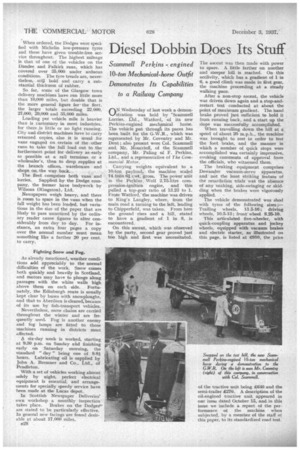Diesel Dobbin Does Its Stuff
Page 26

If you've noticed an error in this article please click here to report it so we can fix it.
Scammell Perkins engined 10-ton Mechanical-horse Outfit Demonstrates Its Capabilities to a Railway Company
When ordered, tne Dodges were specified with Michelin low-pressure tyres and these have given trouble-free service throughout. The highest mileage is that of one of the vehicles on the Dundee and Falkirk runs, which has covered over 35,000 under arduous conditions. The tyre treads are, nevertheless, still bold and carry a substantial thickness of rubber, So far, some of the Glasgow town delivery machines have run little more than 10,000 miles, but double that is the more general figure for' the fleet, the larger totals exceeding 22,000, 27,000, 29,000 and 35,000 miles.
Loading per vehicle mile is heavier than is customary in most industries, for there is little or no light running. City and district machines have to carry returned copies, also it is usual for vans engaged on certain of the other runs to take the lull load out to the furthermost point for delivery as early as possible at a rail terminus. or a wholesaler's, then to drop supplies at the branch offices, warehouses and shops on the way. back.
The fleet comprise:a both vans and lorries. Supplied. by the Dodge company, the former have bodywork by Wilsons (Kingston), Ltd.
Newspapers weigh heavy, and there is room to spare in the vans when the full weight has been loaded, but variations in the size of the paper that are likely to pass unnoticed by the ordinary reader cause figures to alter considerably from day to day. For instance, an extra four pages a copy over the normal number must mean something like a further 20 per cent. to carry,
Fighting Snow and Fog.
As already mentioned, weather conditions add appreciably to the normal difficulties of the work. Snow comes both quickly and heavily in Scotland, and motors may have to plunge along passages with the white walls high above them on each side. Fortunately, the Edinburgh route is usually kept clear by buses with Snowploughs, and that to Aberdeen is cleared, because of its use by fish-transport vehicles.
Nevertheless, snow chains are carried throughout the winter and are frequently used. Fog is another enemy and fog lamps are fitted to those machines running in districts most affected.
• A six-day week is worked, starting at 9.30 p.m. on Sunday aiid finishing early on Saturday morning, the standard " day " being one of 8-81. hours. Lubricating oil is supplied by John A. Bremner and Co., Ltd., of Pendleton.
With a set of vehicles working almost solely by night, perfect electrical equipment is essential, and arrange-. merits for specially speedy service have • been made at the Lucas depot.
in Scottish Newspaper Deliveries' own workshop a monthly inspection takes place. Brakes on the Dodges"' are stated to be particularly effective. In general new facings are found desirable at about 17,000 Miles.
n28
rAN.Wednesday of last week a demon stration was held by 'Scammell Lorries, td., Watford, of its new Perkins-engined mechanical horse. The vehicle put througii its paces has been built for the G-W.R., which was represented by Mr. Coventry and Mr. Dent ; also present were Col. Scammell and, Mr. Moiacrieff, of the Scammell company, Mr. Paling of F. Perkins, Ltd„ and a representative of The Commercial Motor.
Carrying weights equivalent to a 10-ton payload, the machine scaled 14 tons 6/ cwt. .gross. The power unit is the Perkins. Wolf 2.75-litre cornpression-ignitiOn engine, and this pulled a top-gear ratio of 13.23 to 1. From Watford,' the machine was driven to King's Langley, where, from the main road a turning to the left, leading to Chipperfield, was taken. From here the ground rises and a hill, stated to have a gradient of 1 in 8, is encountered.
On this ascent, which was observed by the party, second gear proved just too high and first was necessitated. The ascent was then made with power to spare. A little farther on another and steeper hill is reached. On this acclivity, which has a gradient of 1 in 6, a good climb was made in first gear, the machine proceeding at a steady walking pace.
After a nun-stop ascent, the vehicle was driven down again and a stop-andrestart test conducted at about the point a maximum gradient. The hand brake proved just sufficient to hold it from running back, and a start up the slope was successfully accomplished.
When travelling down the hill at a. speed of about 20 m.p.h., the machine was brought to rest in order to test the foot brake, and the manner in which a number of quick stops were accomplished was certainly impressive, evoking comments of approval from the officials, who witnessed them.
The braking equipment comprises Dewandre vacuum-servo apparatus, and not the least striking feature of the retardation trialswaS the absence of any snaking, side-swinging or skidding when the brakes were vigorougy applied.
The vehicle demonstrated was shod with tyres of the following sizes ;— Trailing wheels, 13 5-16; driving wheels, 10.5-13; front wheel 8.25-10.
This articulated five-wheeler, with quick-coupling apparatus and jockey wheels, equipped with vacuum brakes and electric starter, as illustrated on this page, is listed at E910, the price


































